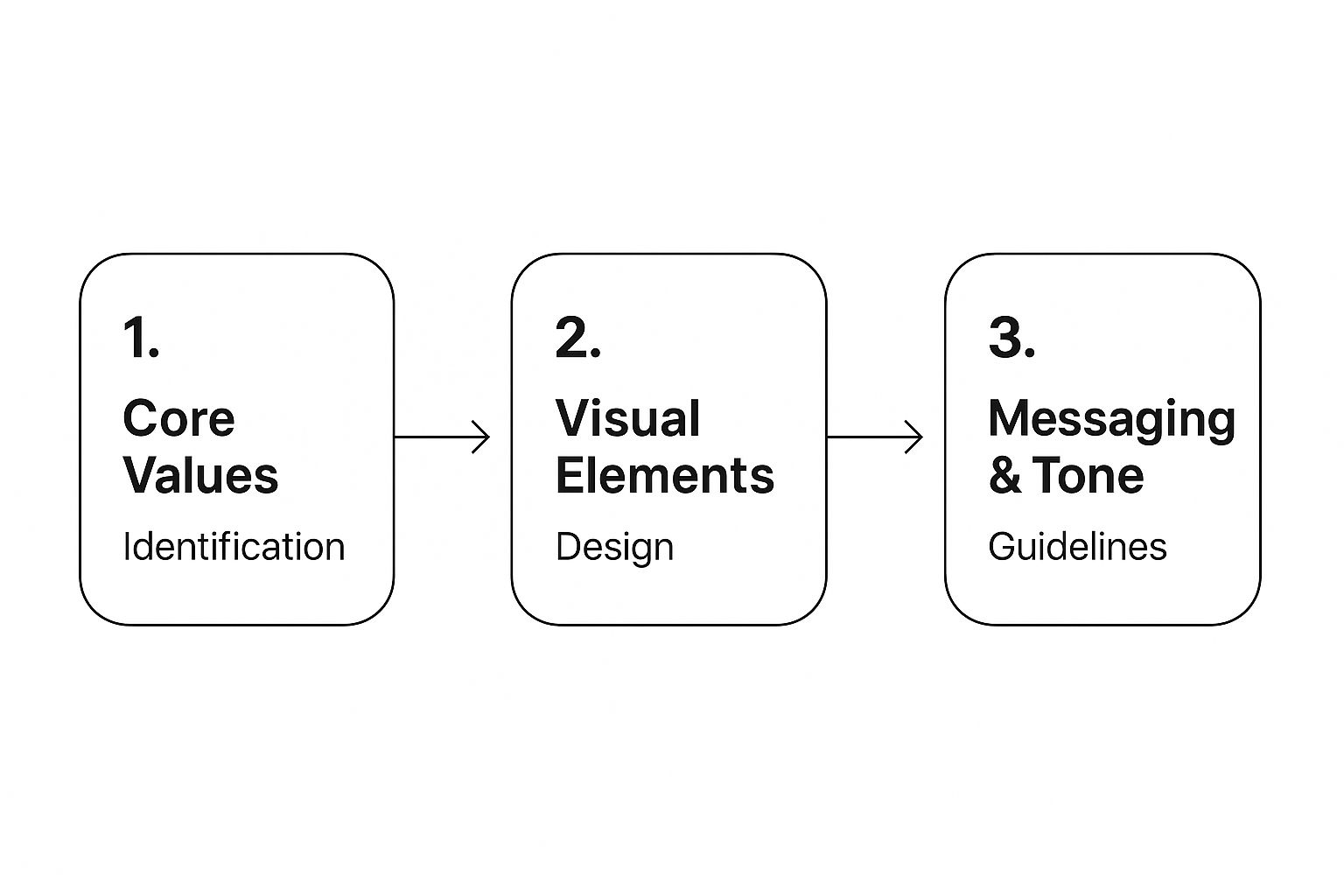Getting your branding for startup companies right isn't just a nice-to-have; it's the most crucial bet you'll make early on. It’s the story that wins over your first customers, convinces investors to take a chance on you, and gets your team pulling in the same direction. It goes way beyond a cool logo—it’s the engine that builds trust and fuels your growth from the very beginning.
Why Branding Is Your Startup's First Big Bet

I've seen too many founders treat branding as an afterthought, something to slap on once the "real work" of building the product is done. That's a huge mistake. Your brand is the sum of every perception people have about your company. It’s that gut feeling someone gets when they hear your name, see your logo, or use your app.
For a new venture trying to make a name for itself in a crowded market, a strong brand isn't a luxury—it’s your secret weapon. It’s the reason someone will choose your unproven startup over a household name they already know and trust.
The True Purpose of Startup Branding
So, what are we really talking about here? At its heart, startup branding is all about creating clarity and forging a genuine connection. It preemptively answers the big questions on your audience's mind:
- Who are you? Your brand clearly states your mission and what makes you different.
- Who is this for? It signals your ideal customer, making them feel like you get them.
- Why should I care? It creates an emotional reason for them to choose you, turning one-time buyers into lifelong fans.
This strategic approach isn't just about feelings; it has a real impact on your growth. Data consistently shows that companies with a strong, cohesive global branding strategy grow 24% faster than their competitors. That’s because a solid brand builds the recognition and trust you absolutely need to get a foothold in the market.
Your brand is the promise you make to your customers. It's a promise of quality, a promise of a certain experience, and a promise of a solution to their problem. Delivering on that promise consistently is how you build a business that lasts.
From Afterthought to Foundational Pillar
Building a great brand starts with a simple mindset shift: see it as a core investment, not a last-minute expense. When done right, your brand becomes the North Star for your entire company. It informs everything from product feature decisions to the tone of your customer support emails.
This ensures every single touchpoint—from the font on your website to the way you post on social media—works together to tell one clear, powerful story.
To give you a clearer picture, here’s how the core pillars of branding directly support key business goals.
The Core Pillars of Startup Branding
This table breaks down the essential components of a strong startup brand and shows how each one delivers tangible results for your business.
Ultimately, a well-defined brand gives you a playbook for everything you do.
Without a brand strategy, your marketing feels like you're just shouting random words into a crowded room. But with one, you’re telling a coherent story that people actually want to listen to and become a part of. This guide will show you exactly how to build that story, turning your startup from just another new business into a brand people remember.
Finding Your Brand’s True North
Before you can build a brand that resonates with customers, you have to get brutally honest with yourself. This is the real starting point for branding for startup companies: a deep, inward look to nail down the why behind your business. This isn't about coming up with clever taglines; it's about building a practical compass that will guide every single decision you make from here on out.
Think of your brand's core as its DNA. It’s the reason your team shows up every morning, and it’s the emotional hook that will eventually turn a casual visitor into a die-hard fan. Ultimately, defining this authentic core is the crucial first step in creating a strong brand identity that actually connects with people.
When you have this internal clarity, everything you do becomes consistent. And in the world of startups, consistency builds trust—which is the most valuable asset you can have.
Nailing Down Your Mission Statement
Your mission statement is your reason for being, plain and simple. It needs to be a short, powerful sentence that answers one question: Why do we exist? Ditch the corporate jargon and complex language. Just be clear.
A solid mission statement works on two levels:
- For your team: It’s a rallying cry. It gives everyone a shared purpose and keeps all hands pulling in the same direction.
- For your customers: It tells them what you’re all about and what problem you’re obsessed with solving for them.
Let's imagine a new fintech startup. A lazy mission might be, "To provide innovative financial solutions." It's forgettable. A much stronger one? "To democratize investing for everyone." Now that’s a mission. It’s active, it’s aspirational, and you get it instantly. It sets a clear path for the whole company.
Painting a Picture of Your Vision
If your mission is the why, your vision is the where. It's a snapshot of the future you’re fighting to create. Your vision statement should describe what the world looks like once your startup has completely knocked it out of the park. It's meant to be big and a little bit scary.
For our fintech startup aiming to "democratize investing," a powerful vision could be: "A world where financial growth is accessible to all, not just the wealthy."
This isn't just about hitting revenue targets. A great vision is about the impact you want to make. It’s the ultimate legacy you're building, and it gives real meaning to the daily grind.
This long-term picture becomes your North Star. Whenever you hit a fork in the road, you can ask a simple question: "Which choice gets us closer to that world?"
Living by Your Core Values
Values are what connect your big-picture mission to your everyday actions. These are the non-negotiable principles that guide how your team behaves, collaborates, and makes decisions. For values to mean anything, they can't just be posters on a wall—they have to be lived out every single day.
Let’s go back to our fintech example. To support its mission, its values might look something like this:
- Radical Transparency: We are brutally honest about fees, risks, and how things work.
- Empathetic Education: We give our users the knowledge to feel confident, not just the tools.
- Simplicity in Design: We make complex financial actions feel effortless and intuitive.
See how these aren't just fluffy ideals? "Radical Transparency" dictates exactly how the app's fee structure is designed. "Empathetic Education" becomes the driving force behind the blog and in-app guides. "Simplicity in Design" informs the entire product roadmap and UX strategy.
Getting the Founding Team on the Same Page
This is the final, critical piece of the puzzle. Your entire founding team has to be completely bought in. This brand DNA isn't a memo sent from the top; it's a shared belief system. The only way to get there is by rolling up your sleeves and doing the work together.
Get in a room and hash it all out. Argue, debate, and whiteboard until you get to the heart of what truly matters to all of you. It can be a messy process, but the alignment you gain is priceless. When everyone is telling the same story and building toward the same vision from day one, you create a unified front that is an incredible advantage in the competitive startup world.
2. Map Your Market and Find Your Edge

Okay, you've looked inward and defined what your brand is all about. Now it’s time to look outward. Great branding for startup companies isn't just about broadcasting who you are; it’s about deeply understanding who you're talking to and who you're competing against. This is where you get tactical, mapping out the competitive landscape to find your own unique, defensible space.
Many founders get intimidated by market research, picturing massive budgets and formal reports. Forget that. The goal here is clarity, not complexity. You just need to become an absolute expert on two things: your customer and your competition. This knowledge is what will stop your brand from just being noise and turn it into something that truly connects.
For a more detailed look at the nuts and bolts, our guide on branding market research lays out some real strategies you can use immediately.
Build Customer Personas That Actually Work
Let's move beyond generic demographics. A truly useful user persona is more than just an age and location; it dives deep into the motivations, frustrations, and goals of your ideal customer. It should feel like a short story about a real person. This helps your entire team build empathy and stay focused on who they're actually serving.
Imagine we're creating a new meal-kit delivery service. We could be targeting two completely different people with the very same product.
Persona 1: "Stressed-Out Sarah"
- Who she is: A 35-year-old working parent, juggling a career and two young kids.
- Her pain point: By the end of the day, she's completely drained. She feels guilty about ordering unhealthy takeout but just doesn't have the mental energy left to plan meals and shop.
- What she values: Convenience is everything. She’s looking for a solution that’s fast, simple, and removes the stress of deciding what to make. Her real goal is to get quality family time back.
Persona 2: "Performance-Focused Pete"
- Who he is: A 28-year-old fitness junkie who's training for a marathon.
- His pain point: He finds it nearly impossible to find meals that hit his exact nutritional targets for protein, carbs, and calories. He dreads his Sunday meal-prep ritual, which eats up half his day.
- What he values: Precision and performance. He needs meals that directly support his fitness goals and eliminate the guesswork. His goal is to optimize his body for peak athletic performance.
See the difference? For Sarah, you’re not selling food; you’re selling time, sanity, and peace of mind. For Pete, you’re selling a competitive edge. This insight shapes everything—your marketing copy, your website photos, and even the types of recipes you develop down the line.
A great user persona transforms your customer from a data point into a person. When your whole team is building for "Sarah," every decision becomes sharper, more focused, and more effective.
Decode Your Competitors' Playbook
Once you know exactly who you’re talking to, you need to understand what they're already hearing from everyone else. Competitive analysis isn't about mimicking your rivals. It's about finding the gaps they’ve left wide open for you to own.
First, identify 3-5 direct and indirect competitors.
- Direct competitors solve the same problem for the same audience (e.g., another meal-kit service).
- Indirect competitors solve the same problem in a different way (e.g., a grocery store's high-end prepared foods counter).
Now, open a simple spreadsheet and start digging. Analyze each competitor across these areas:
The real gold is often hiding in the customer reviews. If you notice every competitor gets slammed for using too much plastic packaging, a brand promise of "100% recyclable materials" can instantly set you apart. If all the others are positioned as gourmet and complex, your angle could be "delicious, home-cooked meals in 15 minutes."
By mapping the market this way, you uncover your unique value proposition—the one compelling thing you can deliver that nobody else is. This is your edge. It's the empty space on the map where you can plant your flag and start building.
You've done the hard work of defining your mission and understanding your market. Now for the fun part: turning that strategic blueprint into something real—something your customers can see, hear, and feel a connection with. This is the moment your brand steps out from behind the curtain and into the real world.
Think of your visual and verbal identity as the clothes your brand wears and the voice it speaks with. It’s the logo people can't forget, the website colors they instantly recognize, and the personality they hear in your social media posts. Nailing this is everything when it comes to building recognition and trust.
Crafting a Memorable Visual Identity
Your visual identity is your brand’s first impression, and you only get one. It's the silent storyteller that conveys who you are before a customer ever reads a single word. This goes way beyond just slapping a logo on things.
A powerful visual identity is a system where every element works together. The key pieces are:
- Logo: This is the cornerstone. It has to be simple, memorable, and flexible. It needs to look just as good on a massive billboard as it does as a tiny favicon in a browser tab.
- Color Palette: Colors are emotional shortcuts. A fintech startup might lean on blues and greys to communicate security, while a new coffee brand might use earthy tones to feel warm and artisanal.
- Typography: The fonts you choose say more than you think. A classic serif font can feel established and authoritative. A clean sans-serif font often feels more modern and approachable.
- Imagery Style: This covers your photos, illustrations, and icons. Are you going for bright, candid shots of real people, or sleek, professional product photography? Whatever you choose, stick with it.
For any new business, building trust is paramount, and visuals do a lot of the heavy lifting. In fact, research shows that 81% of consumers need to trust a brand before they'll buy from it. And with 55% of brand impressions being shaped by visuals alone, you can see how critical professional design is for a startup trying to make its mark.
This isn't just theory. Here's a look at how those abstract values get translated into concrete brand assets.

As you can see, a successful brand identity isn’t an accident. It’s a deliberate process of turning your core strategy into design and messaging that connects.
Defining Your Unique Brand Voice
If your visual identity is how your brand looks, its voice is how it sounds. This is the personality that shines through in every word you write—from your website copy to your customer support emails and social media captions.
Is your brand a witty, clever friend? A calm, reassuring expert? Or maybe a high-energy motivator? Figuring this out isn't just a "nice-to-have." It’s what makes your communication consistent, which in turn builds familiarity and trust. When your voice is solid, customers feel like they know who they're talking to, no matter where they interact with you.
Your brand voice should be an authentic reflection of your company's values and, just as importantly, resonate with the people you’re trying to reach. It’s the difference between sounding like a faceless corporation and a trusted partner.
Start thinking about how you'll put your core messages into words.
- Tagline: A short, punchy phrase that sums you up (think Nike's "Just Do It").
- Value Proposition: A crystal-clear statement explaining what you do, the benefit you provide, and what makes you the best choice.
- Key Messages: The few core ideas you want your audience to remember about you, above all else.
These verbal assets are the other half of the equation, working right alongside your visuals to tell a complete and compelling story.
The Power of a Unified Brand Style Guide
So, how do you keep all of this straight? With a brand style guide. This is your brand's bible, the single source of truth for your entire identity.
Think of it as a rulebook that documents everything from your logo usage and color codes to your tone of voice and even specific grammar preferences. This document is absolutely essential for keeping your brand consistent, especially as your team grows and you bring on freelancers or agencies.
Your style guide ensures every person creating something for your brand—whether it's a blog post, a new ad, or a social media update—is speaking the same visual and verbal language. That unity is what builds powerful brand recognition over time. To really bring this to life online, a solid social media branding guide is an invaluable tool for applying your rules where many customers will see you most.
By carefully building and documenting both your visual and verbal identity, you create a cohesive brand that doesn't just look professional but feels dependable. This is how you stop being just another startup and start becoming a memorable brand.
Taking Your Brand Live and Making It Grow

A brilliant brand strategy is just a document until you put it to work. The real magic of branding for startup companies happens when you take everything you’ve built—your vision, voice, and visuals—and introduce it to the world. This is where your strategy hits the pavement on websites, social media, and in your marketing.
Your goal isn't to be everywhere at once. That’s a common mistake that leads to burnout and a thin, ineffective presence. Instead, you want to be smart and targeted, showing up on the channels where your ideal customers actually hang out.
Where to Plant Your Flag: Choosing Your Digital Channels
Don't feel the pressure to launch on every social media platform simultaneously. It's far better to have a strong, engaging presence on a few key channels than a weak, scattered one across many.
Go back to your customer personas. Where do they really spend their time online?
- If you’re targeting "Performance-Focused Pete," he's probably watching workout tutorials on YouTube, geeking out in fitness forums, and getting motivated by fellow athletes on Instagram.
- "Stressed-Out Sarah," on the other hand, is more likely scrolling through Facebook for local recommendations or browsing Pinterest for quick, easy recipes and life hacks.
By understanding this, you can pick 2-3 core channels to start with. This focused approach lets you create amazing, tailored content for each platform instead of just blasting the same generic message everywhere. This is also a make-or-break decision when building out an https://www.softriver.co/blog/ecommerce-branding-strategy-build-a-strong-sales-driven-brand, as the right channels directly drive sales.
Bringing Your Brand Guide to Life
Your brand style guide is your bible for all things creative. Now, it's time to put it into practice. Every single thing you create, from a detailed blog post to a simple tweet, is a chance to strengthen your brand identity.
Your website is ground zero—your brand's home. It should be the ultimate expression of who you are. Every headline, button, and photo needs to feel like it belongs to your brand.
For social media, you’ll need to adapt. Your witty, informal voice on Twitter might become a bit more polished and aspirational on Instagram, but the core personality must always shine through. As you start executing, knowing the basics of essential public relations for startups can help you get your story in front of a much wider audience beyond just your own channels.
A strong brand doesn't just look and sound consistent; it feels consistent. That feeling of familiarity is what builds trust and makes you memorable.
The Art of Balancing Story and Sales
I've seen so many startups make this mistake: they go too hard on the sales pitch, way too soon. Your online presence can't just be an endless stream of "buy now!" prompts. You have to earn the right to sell by giving your audience real value first.
A smart content strategy balances two key things:
- Brand-Building Content: This is where you tell your story. Share behind-the-scenes glimpses of your company, post about your values, and create content that entertains or educates your audience without an immediate sales hook.
- Sales-Focused Content: This is your direct ask. Think customer testimonials, product demos, special offers, and clear calls to action that guide people toward a purchase.
A good rule to follow is the 80/20 principle. Around 80% of what you post should focus on building your brand and connecting with your community. The other 20% can be more promotional. This method builds a loyal following that’s far more likely to buy when you do present an offer.
Supercharging Your Reach with Paid Ads
Organic growth is fantastic, but it's often a slow burn. Paid advertising is your accelerator, getting your brand in front of fresh eyes—fast. And when you have a clear, solid brand identity, every dollar you spend on ads works that much harder.
Your brand guide ensures your ads are instantly recognizable, building brand recall even among people who don’t click right away. For startups on a tight budget, digital ads are a powerful tool. Pay-per-click (PPC) campaigns are particularly efficient, known to deliver an average of $2 in revenue for every $1 spent—that’s a 200% ROI. This incredible return is why so many new businesses rely on digital ads to build their brand from the ground up.
Think of paid ads as more than just a sales tool; they're a way to tell your brand's story at scale.
Common Questions About Branding for Startups
Navigating the world of branding always brings up a ton of practical questions, especially for startups. Founders are constantly trying to square their big-picture vision with tight budgets and even tighter timelines. This section tackles some of the real-world hurdles you'll face, giving you straightforward answers to help you move forward with confidence.
Even with a perfect plan, building a memorable brand is rarely a straight line. By digging into these common questions, you can get a much clearer sense of the journey ahead. To go even deeper on this topic, check out our detailed post on effective branding for startups to build a unique identity.
How Much Should a Startup Budget for Branding?
There's no magic number here. A good rule of thumb for early-stage startups is to earmark a specific portion of your initial funding for branding. This could be a few thousand dollars for a lean approach—maybe hiring a freelancer for a logo and a basic style guide—or it could climb to $25,000-$50,000+ if you're working with an agency for a comprehensive brand identity.
The key is to think of branding as a foundational investment, not just an expense. If your budget is tight, prioritize a professional logo, a clear brand strategy document (your mission, vision, and values), and a simple one-page style guide. Once you secure more funding, you can invest in more detailed assets and deeper market research.
Can I Build a Strong Brand Myself, or Do I Need an Agency?
It’s definitely possible for a founder with a clear vision and a decent eye for design to get a strong initial brand off the ground. Tools like Canva can help you create your first assets. Honestly, a sharp focus on your core brand strategy—the mission, values, and tone of voice—can take you a very long way on its own.
However, bringing in a professional freelancer or an agency has some serious perks. They provide an objective, outside perspective, which is incredibly valuable. They also bring years of design expertise and an efficiency that's tough to match when you're also trying to build a product and find customers. A pro ensures your brand is not just pretty but also strategically sound and legally defensible, helping with things like trademark availability checks.
A hybrid approach often works best for startups. My advice? Let the founders lead the core strategy—the 'Why' behind the business—and then bring in experts to professionally execute the visual and verbal identity. This gives you the perfect blend of authentic vision and expert implementation.
When Is the Right Time to Rebrand a Startup?
A rebrand should always be a strategic move, not just a reaction to being bored with your old logo. The right time to think about rebranding is when your business has undergone a fundamental shift.
Here are a few key triggers that signal it might be time for a change:
- You've made a major pivot in your business model or are now targeting a completely different audience.
- Your company has grown significantly, and your original branding now feels amateurish or no longer fits.
- You're going through a merger or acquisition that requires a new, unified identity.
- Your brand has developed negative associations you need to distance yourself from.
Remember, rebranding is a major undertaking that can easily confuse your existing customers if it's not handled with care. Before you commit, make sure you know exactly what’s not working with your current brand and have a solid strategy for how the new one will help you achieve your business goals.
How Do I Measure the ROI of My Branding Efforts?
Measuring the return on investment (ROI) for branding can feel a bit fuzzy compared to tracking ad clicks, but it's entirely doable. You just need to look at a mix of metrics that show how people's perception of your brand is impacting your bottom line.
- Brand Awareness: Keep an eye on the "direct traffic" to your website—that’s people typing in your URL directly. Also, track your social media mentions and the search volume for your brand name on Google.
- Customer Perception: Use simple surveys to ask about brand recognition and sentiment. Do people recognize your logo? What three words come to mind when they think of your company?
- Conversion and Loyalty: A trusted brand almost always has a higher website conversion rate. You should also track customer loyalty through repeat purchase rates and customer lifetime value (CLV).
Over time, a strong brand should lead to a lower customer acquisition cost (CAC), because word-of-mouth and brand recognition will start doing more of the heavy lifting for you.
Ready to build a brand that stands out and drives growth? At Softriver, we specialize in creating custom logos and complete brand identities that position startups for success. Our team of top-tier designers delivers professional, market-aligned branding with a streamlined process and a 100% money-back guarantee. Get your brand identity today.







